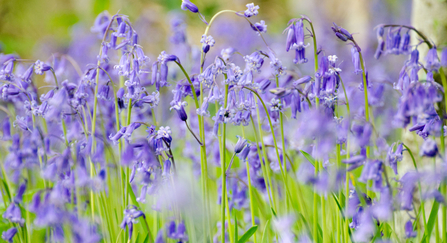
Bluebells by Josh Raper / Conservation Media
Bluebells at Sydlings Copse. Picture: Martyn Lane

Bluebells by Josh Raper / Conservation Media
One of the most joyous experiences of the English spring is walking through a carpet of bluebells in a sun-dappled woodland.
The bluebell spends most of the year as bulb underground in ancient woodland, only emerging to flower and leaf from April onwards. Millions of bulbs may exist in one bluebell wood.
We are lucky to have beautiful displays at numerous BBOWT reserves including Sydlings Copse near Oxford (see the photo at the top of this page!), Foxholes near Buford, Finemere Wood near Bicester and Bowdown Woods near Newbury.
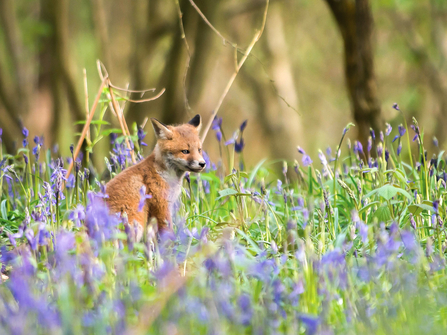
Fox cub in bluebells. Picture: Andrew Marshall
While you're walking through the bluebells, keep a look out for fox cubs! Most cubs are born in mid-March, and this is the time they start to emerge, from about five weeks old.
The cubs are naturally very playful, so if you can find a good vantage point from which to watch, you can see them running and pouncing on each other - an unforgettable experience!
Foxes usually create their burrow systems - called 'earths' - in wooded areas, so any woodland could be a good place to look, but go quietly.
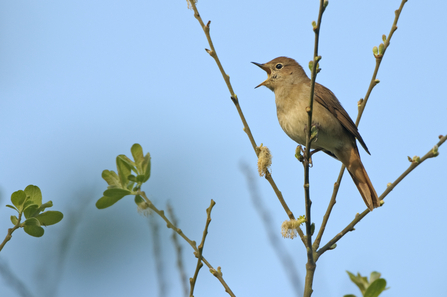
Nightingale © Chris Gomersall/2020VISION
A shy bird, the nightingale is about the same size as a robin and a summer visitor, arriving here in April and leaving in September. Nightingales nest in dense scrub, from where they sing their famously beautiful melodies throughout the day and night.
Two good BBOWT reserves to look out for nightingales are Greenham Common near Newbury and our Hosehill Lake site near Reading.
Listen to their beautiful song:
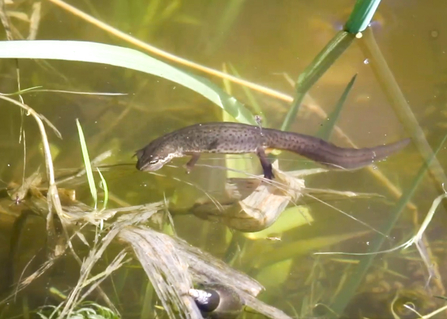
A female smooth newt laying an egg. Picture: Mark Bradfield
Sit by a pond on any warm day from April to July and you may be lucky enough to see a female newt going about the slow, meditative task of laying her eggs.
All three British species of newt (smooth, great crested and palmate) lay their eggs in a similar way, wrapping each one up in a leaf, using plants including water mint, water forget-me-not and Canadian pond weed.
Newts are common across our area, but one of the best ways to see them up-close is to dig your own garden pond! This can also help a host of other wildlife.
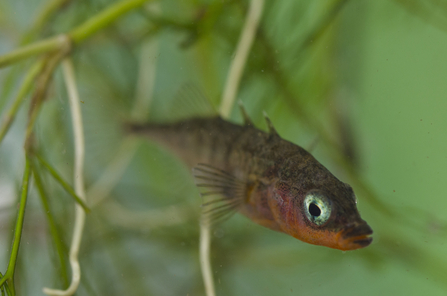
A three-spined stickleback. Picture: Jack Perks
Sticklebacks are iconic as the tiny fish that children catch in streams with jars, but they are more fearsome than their reputation suggests! These fish are actually aggressive predators, hunting tadpoles and small fish, and are also known for fiercely protecting their nest of eggs until they hatch.
At this time of year, the male stickleback develops a bright red throat and belly and performs a courtship dance to attract a mate. He builds a sheltered nest out of vegetation, under which the female will lay up to 400 eggs. The male then defends the nest from other fish until the young hatch up to four weeks later.
Look for them in small rivers and streams, such as at our Letcombe Valley reserve and at Moor Copse.
Male stickleback encouraging a female to lay eggs in his nest © Tom Hibbert

Jon Hawkins - Surrey Hills Photography
While you're down by the water looking for newts and sticklebacks, keep your eyes peeled for the azure flash of the kingfisher darting overhead.
These birds have become symbols of wetland habitat in the UK, but did you know that, rather than building their nests in trees, they dig chambers in the riverbank?
It's also worth looking out for the male's courtship dance, where he stands up tall with his wings forward and whistles softly at the female.
Females will lay a clutch of eggs in the next few weeks which will be just the first of several broods this year.
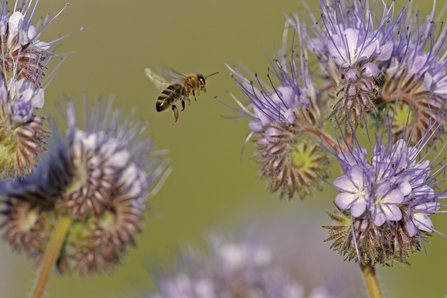
A European honey bee (April melifera) foraging for nectar. Picture: Chris Gomersall/ 2020Vision
As autumn turns into winter each year, honey bee colonies will turf out their useless male drones, and the remaining queen and her female workers huddle together in the hive for warmth.
When it gets warm enough in March and April, the workers will start to venture out once again to gather nectar from the first flowers, which will help feed a new generation in the growing hive.
April also marks the start of the honey bee swarming season, when new queens leave the colonoy with hundreds or thousands of workers to find a new nesting site. The target is usually a hollow tree or disused mammal burrow, but occasionally swarms will alight in public spaces, like the warm bonnet of car. Usually they will move on in a matter of hours if left undisturbed, but the spectacle can draw a bit of attention!

Beefly by Mick Jones
Our largest and most common bee-fly, the dark-edged bee-fly looks just like a bumblebee, and buzzes like one too! It feeds on flowers like primroses and violets in gardens, parks and woodlands.
The slow worm is neither a worm nor a snake, but is, in fact, a legless lizard.
Slow worms can be found in heathland, tussocky grassland, woodland edges and rides where they hunt for invertebrates to eat. They are often found in mature gardens and allotments, where they like hunting around the compost heap.
The mating season for slow worms kicks off in April or May and courtship may last for as long as 10 hours! Females incubate the eggs internally, 'giving birth' to an average of eight young in summer. Look out for them at Greenham Common, Padworth Common and our Warburg Nature Reserve near Henley.
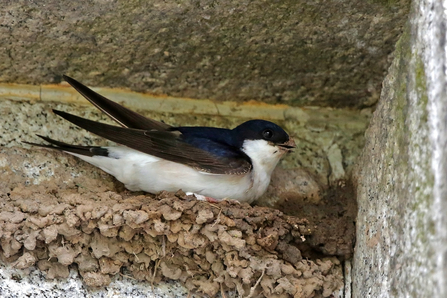
A nesting house martin. Picture: Margaret Holland
Some of our most famous summer visitors start to return to our shores at this time of year.
Having spent the winter in Africa, these species come back to the UK as the weather warms up here to mate and rear their young in places where there are plentiful supplies of juicy insects for them to devour - often near water.
Our College Lake reserve near Aylesbury is a great place to look out for all of these birds, but you can also see them at our Nature Discovery Centre near Newbury, Loddon nature reserve at Twyford and Calvert Jubilee near Bicester.
Sign up below to receive the latest news from BBOWT, tips about how you can help wildlife, plus information on how you can get involved.